ALCHEMY
THE SEARCH FOR THE PHILOSOPHER'S STONE
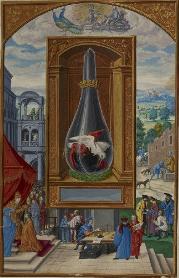
Page from The Renaissance alchemical text The Splendor Solis
THE ORIGINS OF ALCHEMY - The world alchemy is derived from Keme, the ancient Egyptian name for Egypt. Keme translates as black earth and refers to the fertile soil of the Nile Valley as opposed to the red sand of the surrounding desert.
When Alexander the Great conquered Egypt in 332 BC keme entered the Greek language as chemeia, meaning mixture, and during the Middle Ages Islamic scholars added the Arabic word al (the), to create al-chemeia. Yet whether they spoke Greek, Arabic or Latin, all alchemists were preoccupied with one thing - the search for the magical substance which could:
- Turn base metals in gold (chrysopeia)
- Cure all diseases (panacea)
- Dissolve all other substances (alkahest)
This fabled substance became known as the philosopher's stone and the quest to obtain it would occupy learned men from Plato to Isaac Newton.
CLASSICAL ALCHEMY - During the Hellenistic and Roman periods the scholars of Alexandria tried to create artificial gold, silver, pearls and gems by mixing different minerals and subjecting these concoctions to various processes such as distillation. Gradually elements of Greek philosophy, Egyptian astrology, Jewish-Christian mysticism and even Babylonian mathematics were added to the alchemists' increasingly complex recipes.
Towards the end of antiquity alchemy began to include more and more magic and alchemists such as Zosimus of Panopolis (c.300 AD), author of the earliest alchemical text to have survived, claimed that his secret knowledge was a gift from the god Hermes Trismegistus (Hermes Thrice Blessed).
This synthesis of Thoth (Egyptian god of wisdom) and Hermes (messenger of the Greek Gods) was said to have visited earth before the time of Moses and presented the Pharaoh with The Hermetica, a series of books containing the hidden wisdom of the gods. These books, which included the famous Emerald Tablet, taught that wisdom was founded on astrology, alchemy and theurgy (magic) and established the fundamental principle of the occult: As Above So Below.
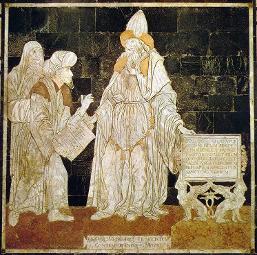
A medieval mosaic in Siena Cathedral depicting Hermes Trismegistus teaching his adepts
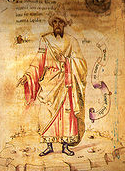
Islamic alchemist Geber (Jabir ibn Hayvan)
ISLAMIC ALCHEMY - In 642 AD Islamic armies conquered Egypt and Arab scholars were quick to adopt the principles of Classical alchemy in their search for the magical al-iskir (elixir). This legendary red dust was the Eastern equivalent of the Western alchemists' philosopher's stone, and equally impossible to isolate.
Nevertheless early Islamic alchemists like Geber began to qualify the four Greek elements (earth, air, fire and water) in terms of four characteristics he called hot dry, cold and moist. From this it was believed that one substance could be changed into another by rearranging these qualities and the 'elixir' was the key ingredient that would effect such a change.
Though they never succeeded in discovering this elixir, Islamic alchemists made great advances in what would become the sciences of chemistry and metallurgy, however this knowledge would not reach the Christian World until The Crusades brought east and west together on the battlefield.
CHRISTIAN ALCHEMY - In 1144 AD Robert of Chester, an English scholar who'd spent many years in Moorish Spain, translated several Classical Greek and Islamic alchemical texts into Latin. His book Liber de Compositione Alchimiae re-introduced the search for the philosopher's stone to western scholars and this 'Magnum Opus' (great work) would occupy students of the occult from Nicolas Flamel to Isaac Newton.
To obtain the mythical stione that transmutes lead into gold, medieval alchemist passed different 'elixirs' through four different processes which matched the Greek elements of earth, air, fire and water with their corresponding 'humours' of black bile, phlegm, yellow bile and blood:
Nigredo [Melanosis] - the blackening: earth - black bile
Albedo [Leucosis] - the whitening: water - phlegm
Citrinitas [Xanthosis] - the yellowing: fire - yellow bile
Rubedo [Iosis] - the redddening: air - blood
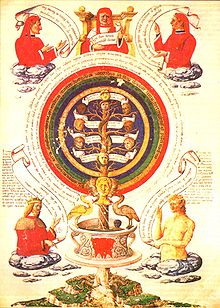
Page from a medieval treatise on alchemy wrongly attributed to Spanish theologian Raymon Llull
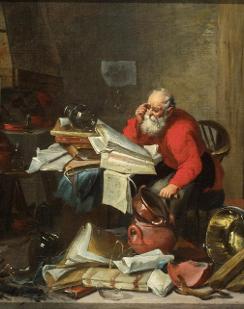
17th Century protrayal of an alchemist by by Dutch painter Matheus Helmont
FROM ALCHEMY TO CHEMISTRY - Though medieval alchemists managed to produce such miracle substances as 'Chinese Salt' (a vital ingredient of gunpowder) they failed in their ultimate quest to find the philosopher's stone. By the end of the Middle Ages, most alchemists were little more than charlatans selling spurious magical charms and amulets but the renewed interest in science and humanism produced by The Renaissance rekindled genuine scholars' search for truth.
The influential German alchemist Cornelius Agrippa was one of the first to question the veracity of alchemy and magic. In later life, even though he found himself safe from the enemies who'd once labelled him a 'Judaising heretic', Agrippa publicly disowned the books he'd written on the occult and spent his remaining days practising medicine in Geneva.
Shortly after Agrippa renounced his beliefs in magic, the famous Swiss physician and alchemist Paracelsus abandoned his own search for the philosopher's stone and began to use zinc, laudanum and other minerals to treat disease.
By abandoning occult texts and magic rituals for observation and experiment, apostate alchemists like Agrippa and Paracelsus inadvertently laid the foundations of modern science. The belief in magic and alchemy may persist to this day but the only certain path to the truth is through the scientific method that observes, hypothesises, tests and modifies.